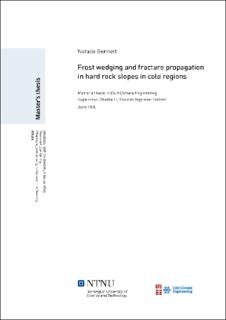| dc.description.abstract | In cold regions, the presence of moisture combined with freezing temperatures leads to a phys- ical weathering process in rocks known as frost weathering. Frost weathering is driven by the volumetric expansion of ice and ice segregation (Matsuoka and Murton, 2008). This study fo- cuses on the former and how it affects the stability of hard rock slopes in cold regions through fracture propagation, frost wedging, and freeze thaw cycles.
The study of fracture propagation assesses this process in two different types of hard rock: Iddefjord Granite and Fauske Marble. The tests are organized into the three following sub cate- gories including 1. basic fracture propagation (Test A), 2. fracture propagation from intervaled infilling of water (Test B), and 3. fracture propagation with a free surface involved (Test C). The results show that significant ice buildup is required to induce fracture propagation from a mechanically made tip (Test A). The interval infilling method (Test B) did not see any fracture propagation throughout the four cycles. Both the basic fracture propagation (Test A) and free surface fracture propagation (Test C) tests exhibited full fracture propagation throughout the samples. Additionally, these results showed that the number of cycles required to fully propa- gate the fracture through the sample is dependent on both the rock type and the distance to the free surface.
The effects of frost wedging are assessed through laboratory work, field investigation, numerical modelling, and analytical approach. A frost wedging test (Test D) was performed in the lab- oratory on two marble samples with wedges created within those samples. The samples were geometrically designed to represent a basic planar failure. One block was created to be a stable wedge, and the other an unstable wedge. The results of the laboratory investigation show that the effects of frost wedging on these samples are independent of the slope of the sliding plane. The field investigation was conducted near Soknedal, Norway, and assessed areas that could potentially have reduced stability due to frost wedging that occurs during months with sub zero temperatures. The analytical approach shows that the uplift from ice formation in joints leads to small horizontal displacements over time. The results of the assessment of frost wedging show that the presence of ice within the joints of a rock mass can lead to slow movements within the rock mass, thereby decreasing the overall stability of the rock mass.
Freeze thaw cycles have been shown to cause damage in the form of physical weathering, and hence, decrease the strength of high porosity rocks. The damage to low porosity rocks is typically less extensive due to their lack of pore space (Matsuoka and Murton, 2008). An analysis of the effects of six freeze thaw cycles is conduced on low porosity Iddefjord Granite core. UCS tests are conducted on the core samples which have been subjected to the freeze thaw cycles and on a control group of core that was never frozen. The results showed no difference in strength from that of the control group.
This study shows that some of the effects of frost weathering, specifically fracture propagation and frost wedging, lead to a decrease in the stability of hard rock slopes in cold regions. | |
